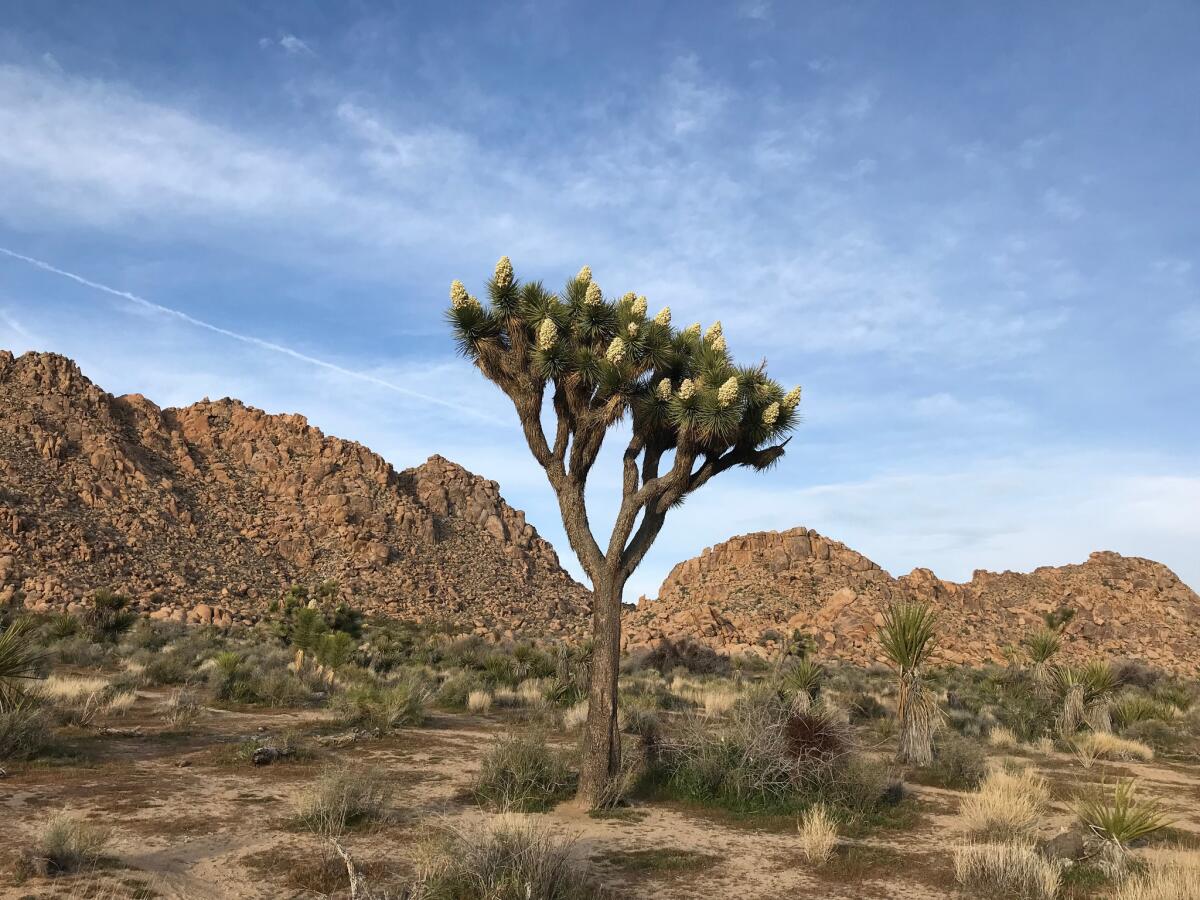Editorial: Climate change is wiping out California’s Joshua trees. Of course we should protect them

- Share via
Imagine Joshua Tree National Park with no Joshua trees.
That is no mere threat. Scientists have repeatedly warned that hotter, drier conditions being fueled by climate change are causing mature western Joshua trees to die off, while fewer younger ones are able to grow to replace the dwindling population. If we don’t act soon, one of California’s iconic and unique trees could be nearly wiped out by the end of the century.
Despite the dire prediction, the Trump administration this year rejected a request to list the western Joshua tree as threatened under the federal Endangered Species Act, which would have made it easier to block projects that threatened the trees’ sensitive habitat or to require developers to take steps to mitigate the potential damage.
The U.S. Fish and Wildlife Service reasoned that there are enough Joshua trees still out there to eliminate the need for protection. To reach that conclusion, the agency downplayed the threat posed by climate change. It was typical of the Trump administration. The president’s refusal to acknowledge climate change makes environmental inaction so much easier to justify.
But there’s still hope. This week, the Center for Biological Diversity sought to have the western Joshua tree listed as threatened in California, under our state’s version of the Endangered Species Act. The group argues that the western Joshua tree is “likely to become endangered in the foreseeable future” without special protection and better management.
The petition focuses exclusively on the type of Joshua tree found across vast swaths of the Mojave Desert, from the northern slopes of the San Gabriel and San Bernardino Mountains to the eastern flanks of the southern Sierra Nevada range and toward Death Valley National Park and into Nevada. There is also an eastern Joshua tree, whose future is uncertain as well. But the western species is an extreme concern because research shows its reproduction has nearly stopped at lower elevations.
At lower elevations, the trees are failing to reproduce because of the warmer temperatures and lack of moisture. At higher elevations, where the trees could probably survive, they face another human-caused environmental risk: Nitrogen-rich smog from the Los Angeles Basin is feeding invasive grasses that threaten the Joshua trees’ desert habitat and eventually become fuel for wildfires that could also decimate the trees.
If humans fail to restrain carbon emissions and global temperatures rise as scientists have warned, virtually the entire Joshua Tree National Park would become a hostile environment for Joshua trees within 80 years.
While climate change is the existential threat to the western Joshua tree, development pressures also pose a risk. About 40% of the trees’ habitat is on private land, and housing tracts, roads, shopping centers, renewable energy facilities, power lines and other projects all whittle away at their numbers. The erosion of available private land makes it especially important that California do as much as possible to protect habitat that will be suitable for the trees to survive and thrive, especially as lower elevations become increasingly inhospitable to the species.
Adding the western Joshua tree to California’s endangered species list will require the state to create a plan to preserve the species wherever it is found. The new plan wouldn’t necessarily stop development completely, but it would force scrutiny of projects that would damage the trees or diminish their habitat. The center’s petition kicks off a lengthy process, including state officials looking at the biological and scientific evidence to justify protection. The California Fish and Game Commission ultimately votes on whether to list the species.
If future generations are going to enjoy and admire Joshua trees in the wild, then California leaders are going to have to take much more aggressive action to protect the trees and their landscape today. It’s also yet another reminder of how climate change will wreak devastation on the icons of our environment. Without serious action now, we can add the Joshua tree to the growing list of species and locations imperiled by the world’s dependence on fossil fuels and our refusal to take aggressive steps to end that reliance.
More to Read
A cure for the common opinion
Get thought-provoking perspectives with our weekly newsletter.
You may occasionally receive promotional content from the Los Angeles Times.










